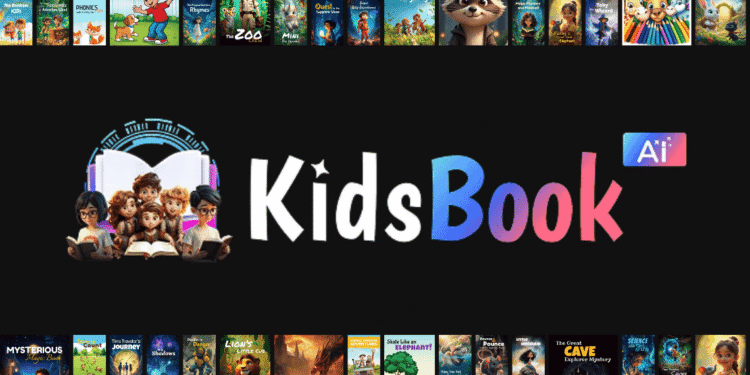Let me guess.
You’ve been scrolling through success stories at 2 AM. Watching regular people claim they’re banking $5K/month selling AI-generated children’s books. Your BS detector is screaming “too good to be true” while another part of you whispers “but what if…?”
Well, this is how I found KidsBook AI.
Here’s the storyboard: The children’s content market is a $438 billion behemoth, and AI just kicked the door wide open for anyone with a laptop and a dream.
But before you start mentally spending those Amazon royalties, we need to talk about what’s really happening with platforms like KidsBook AI.
Because the difference between another abandoned side hustle and a legitimate income stream? It’s knowing exactly what you’re getting into.
KidsBook AI claims to be your skeleton key to this kingdom—transforming raw ideas into published children’s books faster than traditional authors can finish their morning coffee. But does it deliver on that promise, or is it just another tool riding the AI hype train?
Let’s strip away the marketing fluff and examine what this platform actually does, who it’s genuinely built for, and whether it can realistically fuel your publishing ambitions.
Disclosure: This review contains affiliate links. Purchasing through our links may result in a commission for us, at no additional cost to you. This supports our work in providing in-depth analyses. Our commitment to unbiased evaluation remains paramount.
Quick verdict
Product: KidsBook AI
Overall ACR Rating: 8.7
Best Suited For:
- Online entrepreneurs who've felt the frustration of complex tech demands and are seeking a more direct path to generating income.
- Aspiring publishers daunted by the steep costs of traditional book creation and looking for a way to produce scalable digital products.
- Creative individuals who possess imagination but perhaps not the artistic skills and yearn to share their stories with great visuals.
Key AI Technologies Covered:
- Keyword-to-story generation
- Automated illustration creation
- AI voice narration
- Interactive book elements
- Multi-language capabilities
The Goods:
- 👍 Complete books in under 30 minutes from initial idea to finished product.
- 👍 No technical or artistic skills required – truly.
- 👍 Commercial rights included to sell unlimited books.
- 👍 Multiple income streams possible from a single creation.
The Trade-offs:
- 👎 Output quality can depend on input clarity, requiring some experimentation.
- 👎 Requires an internet connection as it's a cloud-based tool.
- 👎 Some creative boundaries exist within the template system.
Explore if KidsBook AI Aligns with Your Creative Goals
What you are looking for
What makes KidsBook AI different
The children’s book market. $438 billion of opportunity.
Yet for most aspiring creators, it might as well be on Mars. Traditional publishing demands a perfect storm of talent, connections, timing, and often, sheer luck.
KidsBook AI proposes something radical: collapse the entire production chain into one AI-powered cockpit.
Think about the typical AI content creation journey. You’re juggling multiple subscriptions—one for writing, another for images, maybe a third for audio. Each with its own interface, learning curve, and compatibility headaches. A fellow creator recently described their weekend: “I spent more time trying to make different AI tools play nice than actually creating. It was digital torture.”
KidsBook AI takes a different stance: unified creation. You bring the idea. The platform handles story crafting, illustration, narration, and formatting—all under one roof.
But here’s the real differentiator: this isn’t some generic content generator wearing a children’s book costume. The AI models are specifically trained on children’s literature patterns. Age-appropriate vocabulary, story structures that hold young attention, educational undertones that parents appreciate—it’s all baked into the algorithms.
The result? Newcomers produce market-ready books at speeds that make traditional authors question their entire process. We’re not talking months of development anymore. We’re talking about transforming napkin sketches into sellable products during your lunch break.
Inside look at how the AI actually works
Let me try pull back the curtain on the tech, without getting overly technical.
KidsBook AI uses what's called a “multi-model AI approach.” Imagine a skilled storyteller, a talented illustrator, and a clear narrator all collaborating instantly. That's the essence of what's happening here.
The Three-Step Creative Process:
Step 1 – Input Your Spark
You provide the starting point. This could be:
- A simple keyword like “brave puppy”
- A URL to an article you want transformed
- A PDF with educational content
- Even just a rough idea in your head
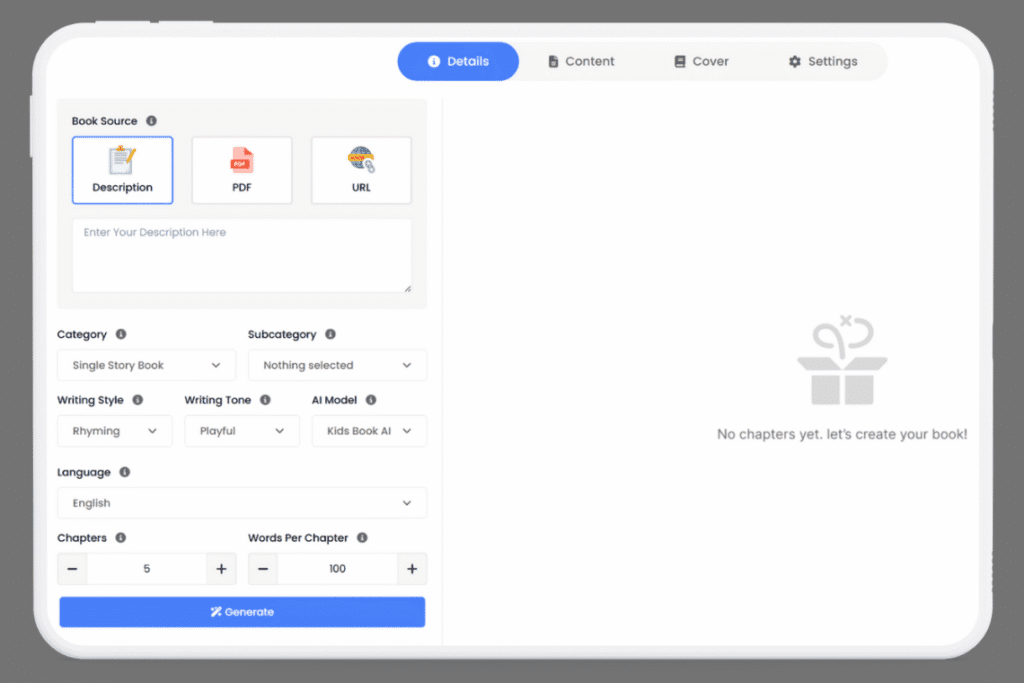

Step 2 – AI Transformation
The platform's AI engines spring into action:
- Story AI crafts a complete narrative with proper structure.
- Illustration AI generates unique images for each page.
- Voice AI creates natural-sounding narration.
- Integration AI pulls everything together seamlessly.
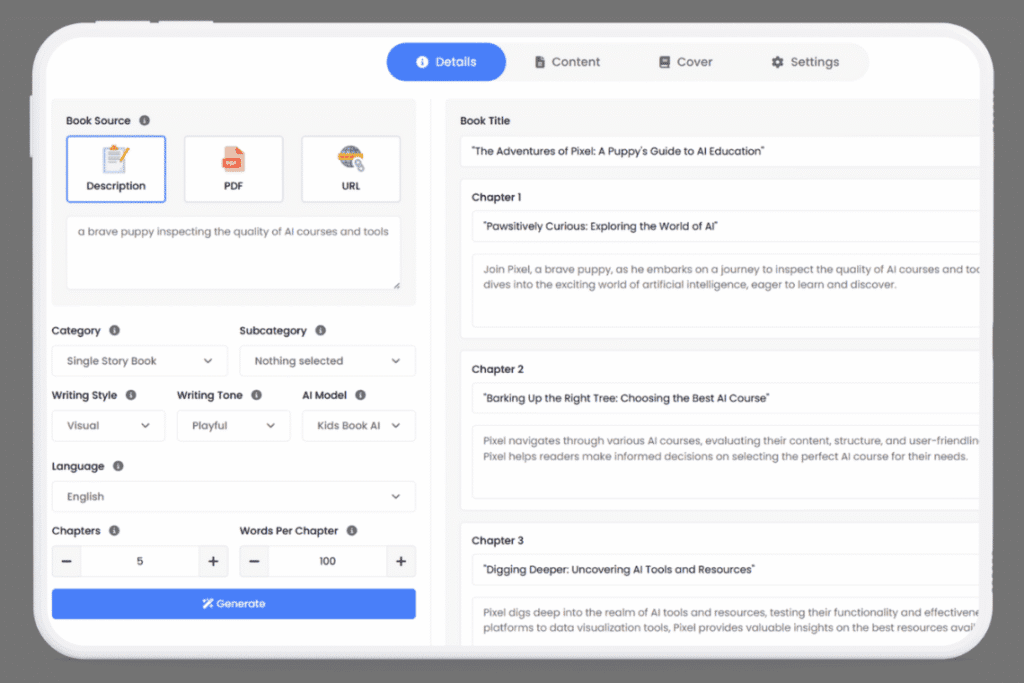

Step 3 – Your Finishing Touch
A drag-and-drop editor lets you:
- Adjust any text or images.
- Add interactive elements.
- Include your branding.
- Export in multiple formats.
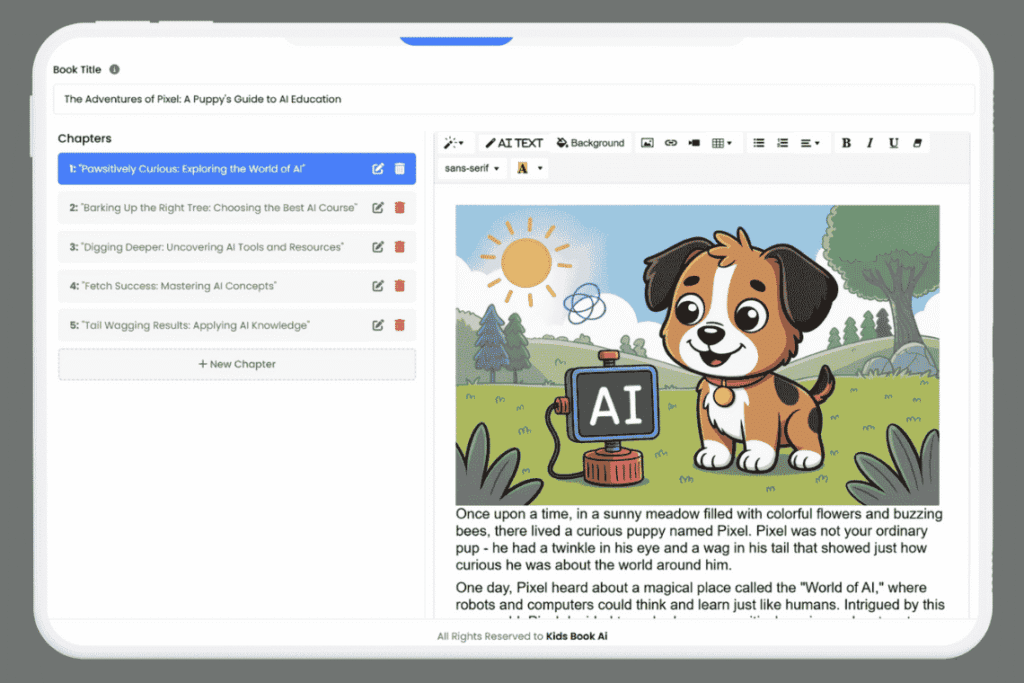

What's particularly impressive is how the AI maintains consistency. Characters tend to look the same throughout the book. The story flows with a clear beginning, middle, and end. The illustrations generally match the text well. Not just random generation.
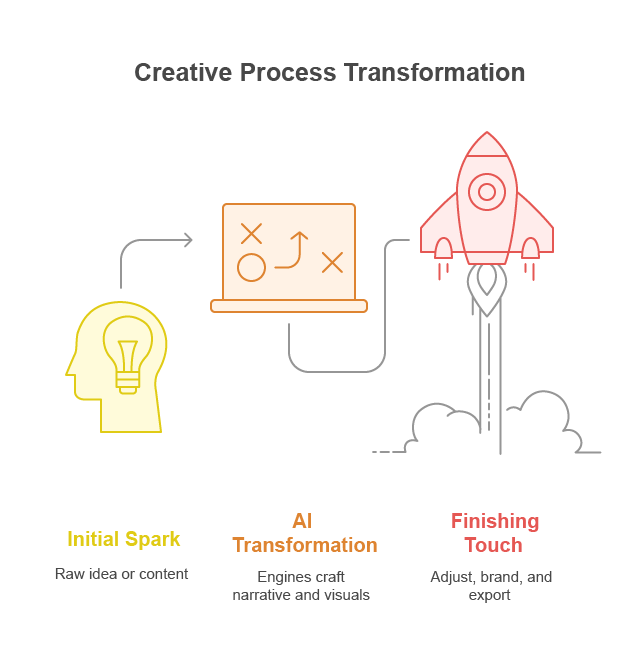

The features that turn ideas into income
Now for the money talk.
Let's get specific about what you actually get and why it matters for your potential earnings.
Instant Story Generation from Keywords
In my first try, I typed “a brave puppy inspecting the quality of AI courses and tools” into the description box and watched KidsBook AI attempts to create an entire adventure. The goal is character development, plot points, educational moments, and satisfying endings. This can save you significant writing time, moving you quickly towards having a product.
The system understands child psychology basics—simpler structures for toddlers, more complex adventures for older kids. This built-in awareness increases your books’ market fit from day one.
Professional Illustrations Without an Artist
Traditional illustration costs? $100-$300 per page. For a 20-page book, you’re looking at $2,000-$6,000 investment. KidsBook AI? Unlimited AI-generated illustrations included.
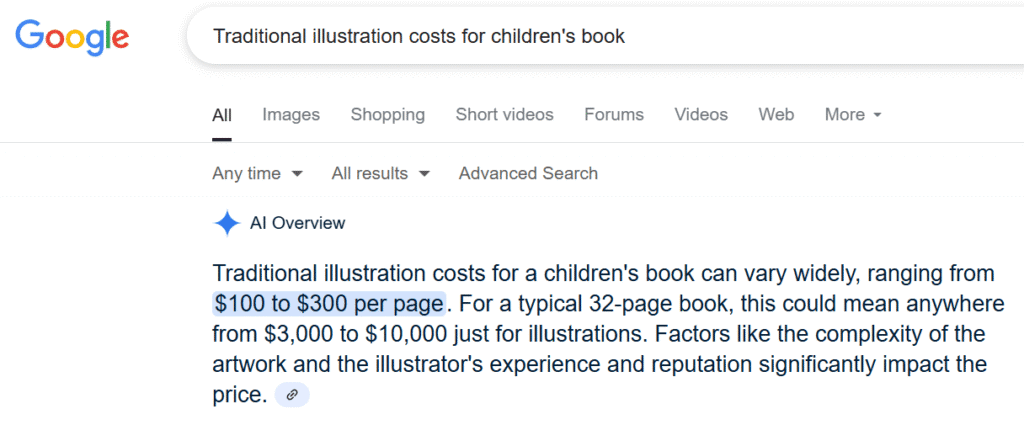

These aren’t recycled clip art. The AI creates custom visuals for your exact story. Want a purple elephant wearing sneakers? You can try. Need an underwater castle made of seashells? Input it and see.
Talking books that command premium prices
Static ebooks typically sell for $0.99-$2.99. Interactive talking books? They command $4.99-$9.99 because parents see higher educational value.
The AI narration generally sounds natural. Text can highlight as the narrator reads, helping children follow along.
You can also add:
- Background music
- Sound effects
- Character voices
- Interactive quizzes
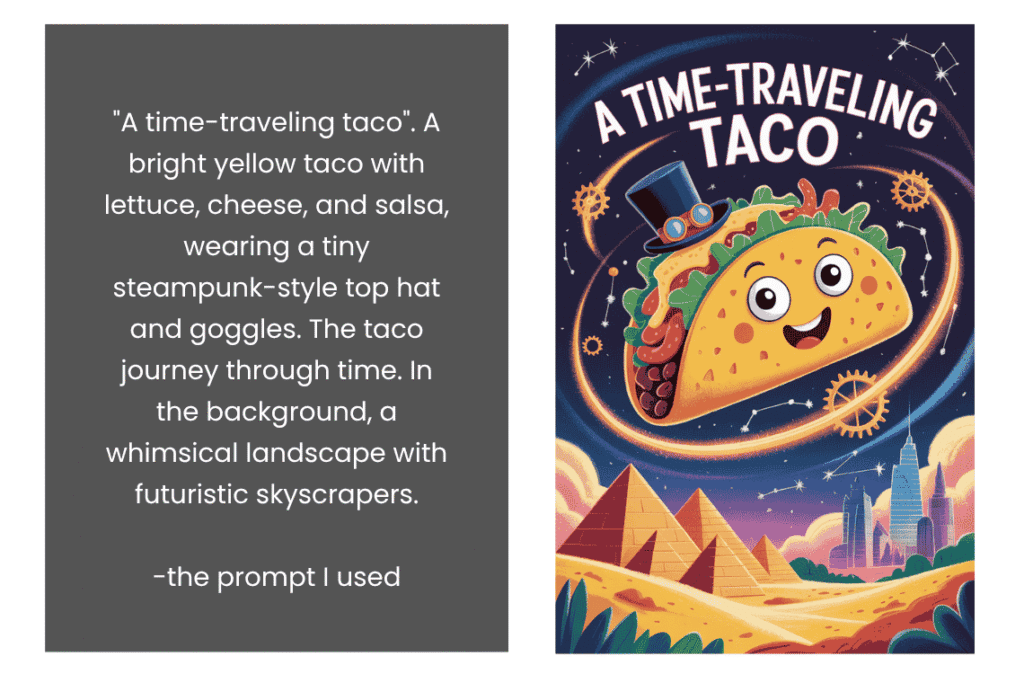

Commercial license that changes everything
This is huge. You get full commercial rights to every creation. No royalty splits. No licensing headaches. No sales caps.
Compare that to freelance contracts with murky ownership terms or platforms taking perpetual cuts. Every penny of profit from your sales stays in your pocket.
One Book, Many Revenue Streams
Each book becomes a multi-format asset:
- PDF for Amazon KDP (print-on-demand and ebook)
- Flipbook for your website (sell direct)
- Video format for course content or TikTok/YouTube
- Web version for subscriptions (recurring income)
You’re not just making A book. You're creating an asset with the potential to generate income in multiple ways.
Templates that look designer-made
Even with AI doing the heavy lifting, design matters. KidsBook AI includes professionally crafted templates designed to make the books look polished.
Some of my personal favs:
- Whimsical watercolor
- Bold cartoon
- Classic storybook
- Cut & assemble Books
These templates handle aspects of spacing, fonts, and layouts automatically. Your books can look professional even if you've never designed anything before.
In the vidoe above, I made a cut, color and assemble book, just like that.!
My first book
Theory’s great. Practice reveals truth.
Here’s my experience in a real-world creation scenario.
Conceptual Starting Point
I picked a universal childhood challenge: fear of the dark. Relatable theme, clear market need, perfect for testing the AI’s emotional intelligence.
The Creation Process
Input Phase (2 mins)
I logged in, clicked “Create New Book,” and in the keyword box, I typed: “little star helps child overcome fear of dark.” Hit enter. Held my breath.
AI Generation (3 mins)
The system churned. Then, boom:
- Main character established (Twinkle the Star)
- Coherent plot emerged (Twinkle teaching Leo nighttime isn’t scary)
- 12 pages of age-appropriate text materialized
- Soothing, colorful illustrations appeared
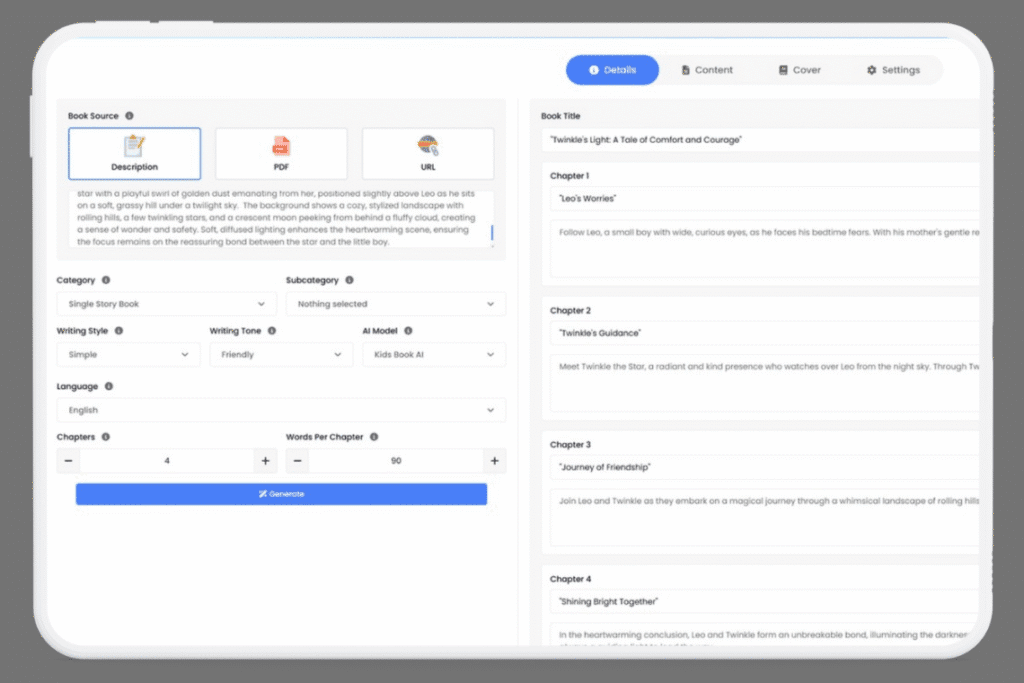

Customization (15 mins)
This felt like actual creative work:
- I changed Leo's hair color to look a bit like my nephew.
- I added a “goodnight ritual” page, thinking about extra educational value for parents.
- I selected some soft background music for the narration.
- I even popped in a gentle quiz about facing fears. It felt less like editing and more like playfully enhancing.
Export and Ready (10 mins)
With a few more clicks, I downloaded multiple versions:
- High-res PDF for Amazon KDP printing
- Interactive flipbook for a website
- Video version for YouTube
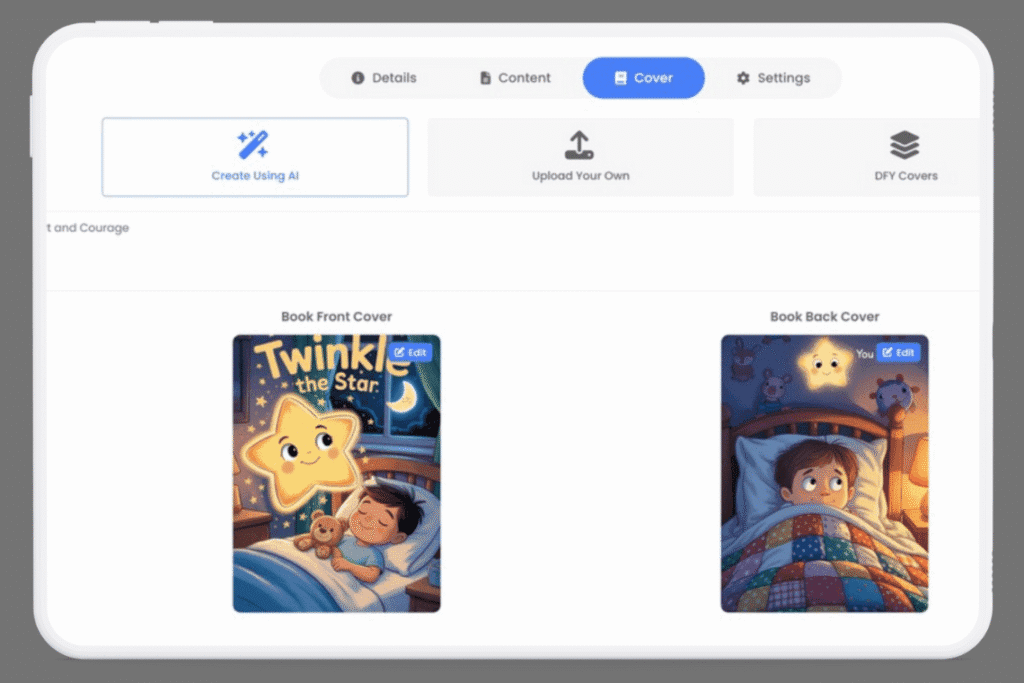

Total Time: 30 minutes from concept to finished products.
Thirty minutes. That’s shorter than most meetings about having meetings. Yet I held a complete, illustrated, narrated children’s book across multiple formats. No struggling with software, no writer's block, no technical headaches. Just an idea, a few keywords, and viola! The time we are living now!
Real numbers behind the investment
Let’s talk dollars and sense because ROI is what matters.
Front-End Access: One-time payment ($37 at the launch special)
No Monthly Fees for core creation features
Optional Upgrades: Enhanced features, higher quotas, agency rights
Writer: $500 – $2,000+
Illustrator: $1,000 – $5,000+
Editor: $300 – $800+
Formatter: $200 – $500+
Total: $2,000 – $8,300+ per book
Average eBook Price: $2.99 – $4.99
Amazon KDP Royalty (70%): ~$2.09 – $3.49 per sale
Modest Success: 5 daily sales = $313 – $523/month per book
Scale to 10 Books: Potential $3,130 – $5,230/month
Choosing the right toolkit
Creator's Launchpad
KidsBook AI Commercial
Launch Only! Rises to $47
Essential Book Creation
Create talking & flipbooks
AI story & illustration
AI narration included
Publish & Sell Basics
Full commercial license
Reach 30k readers/month
Share books easily
Core Design Tools
Designer cover templates
Drag & drop editor
AI eCover generator
Unlimited Publisher
KidsBook AI Elite
Commercial + Elite Upgrade
Limitless Book Creation
All Commercial features PLUS:
Unlimited books & flipbooks
Unlimited AI image credits
Unlimited creation credits
Global Reach Power
Unlimited readers & traffic
Create in any language
Unlimited sharing & embeds
Enhanced Design Suite
50+ extra Done-For-You templates
Organize in workspaces
Design social posts
Empire Builder's Suite
KidsBook AI Fast Pass
Commercial + All 5 Upgrades – Best Value!
Ultimate Creation Suite
Advanced AI voice cloning
1500+ pro AI voices
Huge music/SFX library
Done For You
50 ready-to-sell DFY books
DFY marketing assets
50k PLR eBooks & articles
Full marketing strategy guide
Pro Monetization & Traffic
Direct KDP publishing
In-book ads & lead forms
Advanced traffic analytics
Additional Costs to Consider
- The Commercial package is your ideal entry to learn and launch.
- Elite unleashes your ability to create and reach without limits.
- The Fast Pass offers every conceivable tool for a dominant publishing business at a substantial saving.
The math is compelling. One moderately successful book could potentially pay for the entire platform. Everything after that is profit. I've seen user from Kids Book AI's close beta, report creating 20-30 books in their first month—ambitious but achievable.
Additional Costs to Consider
- Amazon KDP Account: Free
- ISBNs (optional): ~$125 for 10
- Basic Marketing: $50-100/month starting
- Time Investment: 1-2 hours per book initially
Even accounting for these, you're looking at potentially high profit margins compared to traditional publishing.
How KidsBook AI stacks against alternatives
Our team at ACR have tested numerous platforms on AI book creation, published a deep-look a while ago, here’s our study on how KidsBook AI stacks up.
Versus the “DIY Stack” (Canva + ChatGPT + Midjourney)
There is nothing wrong about cobbling together free tools, but for serious-result seekers:
- Requires juggling 3-4 platforms/subscriptions
- Manual integration eats hours
- Maintaining visual consistency is at random, a friend of mine mentioned spending an entire evening just trying to get illustrations to look consistent with a story from ChatGPT.
- No interactive “talking book” feature
- Verdict: KidsBook AI wins on speed, integration, and specialized output
Versus Hiring Freelancers
The traditional outsourcing route (being worked with outsourced team myself):
- Minimum $1,000 per book investment
- 4-8 week turnaround times
- Back and forth revisions
- Copyright discussions and contracts are necessary.
- Communication delay happens
- Verdict: KidsBook AI wins on cost, speed, and direct control.
Versus Generic AI Platforms
General content tools attempting children’s books:
- Generic AI tools often miss the mark for this niche:
- Not optimized for children's specific content needs.
- May lack age-appropriate features and sensitivities.
- Educational elements might be harder to incorporate.
- Narration capabilities are often limited or absent.
- Can still require significant technical know-how.
- Verdict: KidsBook AI’s specialization provides clear advantages
Among all, the ‘DIY Stack' (e.g., Canva + ChatGPT + Midjourney) offers a high degree of granular control, which can be wonderful for those with significant time and technical skill to invest in mastering and integrating disparate tools. However, for individuals prioritizing a streamlined workflow, consistent stylistic output, and integrated interactive features specifically for children's literature, KidsBook AI presents a more cohesive and efficient solution.
To simply put, as untill today, while alternatives exist, none currently match the complete, specialized package KidsBook AI offers for children's book creation.


Who should buy this and who should skip it
Success with any tool depends on alignment between capabilities and goals.
Perfect Match If You Are
The Side Hustle Seeker
You work full-time but want extra income. You have 1-2 hours spare in the evenings. You're tired of low-return online tasks. A colleague in a similar boat mentioned, “I wanted a real side business, not just digital busywork. KidsBook AI let me build something tangible in my spare time.” This gives you a genuine business you can build gradually.
The Digital Entrepreneur
You see others succeeding online but feel left behind by technical complexities. You want something proven, not experimental. This offers a clearer path from zero to potential income, bypassing many common hurdles.
The Creative Parent or Teacher
You have story ideas but perhaps not the illustration skills or time. You want to create custom content for children. You'd love to earn from your creativity. This can turn your ideas into products swiftly.
The Future Agency Owner
You envision offering content creation services to others. You want to scale beyond trading time for money. You're ready to build something bigger. This provides a strong foundation, especially with agency upgrade options.
Should Look Elsewhere If
You Expect Overnight Riches
No tool magically creates money. Success requires consistent creation, some learning, and basic marketing. If you won't commit to publishing regularly, this might not be the right fit.
You're Fundamentally Against AI in Creative Fields
Some people believe only human-created art has true value. That's a valid perspective, but this tool is built on AI from the ground up.
You Aim for Literary Masterpieces:
This tool creates engaging, marketable children's books efficiently. It's not designed to produce the next Where the Wild Things Are. For simple, appealing, and potentially profitable kids' content, it's very effective. For complex, nuanced literature, traditional routes are likely better.
The bottom line on your kids book business
Does KidsBook AI Deliver on Income Generation?
After extensive testing, our answer at ACR editory team is yes – with realistic expectations and consistent effort.
The platform legitimately lowers barriers that traditionally gatekeep the children’s book market. Artistic skills become optional. Writing expertise isn’t prerequisite. Massive capital requirements disappear.
What remains is a genuine business opportunity requiring dedication and strategic thinking. Not instant riches, but sustainable monthly revenue that scales with your effort.
Detailed ACR Scorecard
Core AI Functionality & Effectiveness: 9/10
The AI consistently produces content ready for market with minimal refinement. Output quality impresses, especially given the simple inputs required. Like any AI tool, occasional regeneration or tweaking optimizes results—that’s normal, not a flaw.
Practical Application & Income Potential: 8/10
Clear evidence exists of users generating real income. Earnings vary based on effort, marketing savvy, and niche selection, but the underlying potential is proven. The full commercial license alone provides exceptional value.
Pricing, Transparency & Overall Value: 9/10
The one-time fee for unlimited book creation costs less than illustrating a single traditional book. ROI potential is exceptional. No hidden fees surfaced during evaluation.
Overall Rating: 8.7/10 ACR Points
Our recommendation for success
Base on our team's hands-on with KidsBook AI, we recommend to pace yourself into a realistic, actionable plans. In fact, we drafted one for you:
Week 1-2: Learn the platform, create and experiment with 5-10 books.
Week 3-4: Publish on Amazon KDP, test different niches and keywords.
Month 2: Analyze what's working, scale your efforts, aim for 2-3 new books weekly.
Month 3+: Explore additional platforms (your own site, other marketplaces) and income streams (bundles, series).
The key? Consistent, strategic action. While KidsBook AI automates creation, this remains a “semi-passive” model. You invest effort creating assets once, then they generate ongoing revenue—but initial creation and marketing require your active engagement.
Making Your Decision
Children’s content demand never stops. Parents and educators always need quality content. The question isn’t whether opportunity exists—it’s whether you’ll seize it.
If you’re prepared to:
- Invest 1-2 hours per book initially to learn and refine.
- Publish consistently (not just one book and then wait).
- Learn basic marketing (understanding keywords, categories, and appealing covers).
- View this as a real business opportunity, not a lottery ticket.
Then KidsBook AI provides a powerful toolkit to help you succeed.
Since platforms often launch with special pricing that increases over time, exploring KidsBook AI sooner rather than later could prove advantageous.
Start Building Your Kids Book Income Strategy Today
Frequently Asked Questions


Ready to transform simple ideas into potentially profitable children’s books? The opportunity is real, the tools are designed to work, and the market is waiting. Your journey from beginner to published author could start with one click.
Claim Your Access to KidsBook AI and Start Creating Now
The Review
KidsBook AI
KidsBook AI creates engaging, marketable children's books efficiently. It's not designed to produce the next Where the Wild Things Are. For simple, appealing, and potentially profitable kids' content, it's very effective. For complex, nuanced literature, traditional routes are likely better.
PROS
- Complete books in under 30 minutes
- No technical or artistic skills required
- Commercial rights included
- Multiple income streams possible
CONS
- Output quality can depend on input clarity
- Requires an internet connection
- Some creative boundaries exist within the template system
KidsBook AI DEALS
We collect information from many stores for best price available

